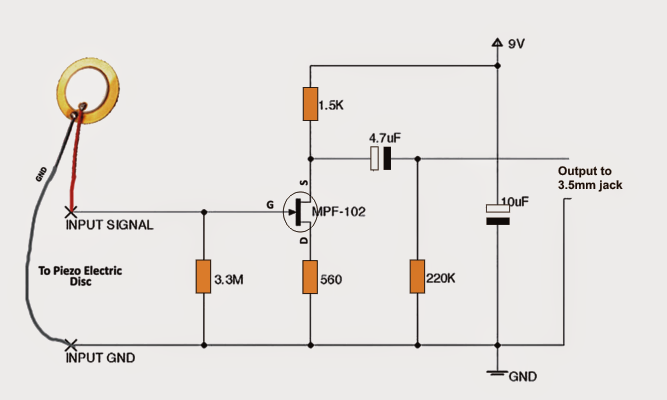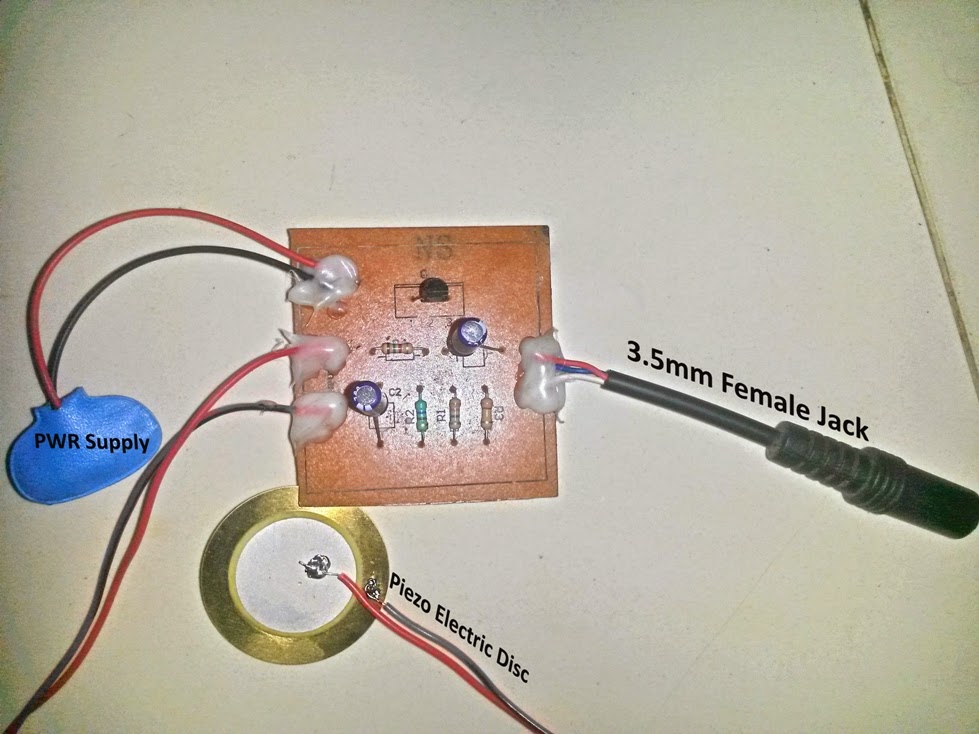Contact mics enable you to feel uncommon sounds when connected to numerous surfaces.It also Generate sound when voltage is used on it.With the guide of a fundamental Pre-amp circuit it may also serve to Electrify an Acoustic Guitar, where amplification is essential.

A piezoelectric disk produces a voltage when deformed. Piezo elements are useful when needing to identify vibration or a knock. You can utilize these for tap or knock sensors quite conveniently by studying the voltage on the output. They are able to as well serve for a small audio transducer for example a Buzzer.
The trick is the preamp - a simple circuit accustomed to match the piezo’s signal.The derived piezo/preamp combo can be utilized for electrifying an acoustic guitar.
Circuit Explanation
The battery offers +9 volts which can be linked to the source of the JFET device, MPF-102. This voltage is attached to the source by means of source resistor 1.5K.
One terminal of this amplifier is well-known to both the input and output signals. This terminal is the JFET drain terminal. Because of this, we occasionally call this amplifier circuit a "common drain circuit”.The Drain resistor 220k is linked to the source to the battery's ground terminal.
The main Element utilized in the circuit is the MPF-102 Transistor. Under no-signal situations, bias voltage leads to the JFET source to obtain a very small current. This current sets the source voltage at a point halfway between the Supply and ground.This is the suggested bias setting for most small-signal or analog audio amplifiers.It permits the maximum signal before distortion.
The signal penetrates the amplifier by way of gate resistor 3.3M. The voltage drop across 3.3M is the input signal at the JFET gate. This signal is an AC voltage. The signal enters JFET,which is a amplifying device.The variance between the source and the gate sets the voltage drop across resistor 560 Ω. Typically, the bias voltage across resistor 560 Ω carries the JFET channel at a medium resistance value. The bias voltage is a DC voltage. When we use a signal, the input signal differs the negative bias voltage across resistor 560 Ω.
The different gate signal brings about the JFET's to differ. For that reason, generally current transmits through the JFET. The source resistor 1.5K transforms the current variations to voltage variations. Considering that the input signal handles the channel width.That is, a small signal manages a large signal. In our situation, the JFET gate voltage handles the JFET source current. This result’s in Amplification.
The output signal seems between the Source and ground. Capacitor 4.7uF blocks the DC voltages in the circuit, but transmits the amplified AC signal.The gate is much more harmful than the ground terminal. Now the output is developed across the Source and ground. But we've linked the Source to Supply. Then the Source is a lot more positive than the ground terminal. With the gate negative and the Source positive, This output signal simply leaves the amplifier by means of capacitor 4.7uF and shows up across resistor 220k. This Capacitor obstructs DC and moves only.
PCB Design for the above described DIY contact MIC circuit

Following are the images of the DIY contact mic prototype.


Renault says
Hi, I am trying to use a J113 JFET as a direct replacement in this circuit. I can’t seem to get it to work. Any ideas? Or can you recommend any other substitute FETs?
Thanks
admin says
Hi, actually the number of the shown jfet is not at all critical, so I am not sure why your version may not be working, you can refer to the datasheet of the shown jfet number and check whether your version is missing something from the original one or not…by comparing the main features and specs from their respective datasheets you should be able to figure out the most favorable alternative….hopefully.